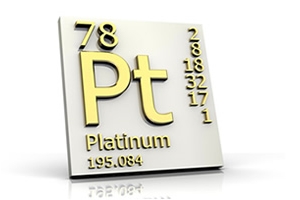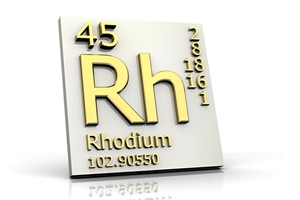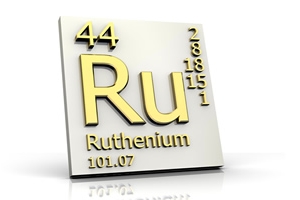The six metals
The six platinum group metals are crucial to our daily lives. From fountain pens to aircraft turbines, from anti-cancer drugs to mobile phones, from catalytic converters for automobiles to ceramic glazes, PGMs play a vital role at the heart of everyday living.
PGMs will also be central to our future choices in the fields of power generation, transportation, healthcare and a host of other areas. Found together in nature and similar in their chemical properties, PGMs are located next to each other in the periodic table.
PGMs are uniquely durable and can be used extremely efficiently – meaning that a very little goes a very long way. When recycled, over 95% of PGMs are recovered through highly efficient recycling techniques. Their recyclability means that they have a uniquely long lifecycle, allowing them to contribute significantly to the protection of the environment by reducing any negative impact which is normally associated with metal waste disposal.
Supply & Demand facts
- The PGMs are mined as a basket – in other words together; none of the PGM are mined as individual metals in their own right.
- The main source of primary PGMs – and by far the largest known deposit of these metals on Earth – is the Bushveld Igneous Complex
(BIC) in South Africa. - Over 70% of platinum comes from South Africa and Zimbabwe, 12% is produced in Russia, and the remaining 15% is sourced from other countries, like Canada and the USA (source: Johnson Matthey PGM Market Report 2024).
- The largest consumer of platinum is the automotive industry, where Pt is used in catalytic converters to clean exhaust fumes from vehicles; use in fuel cell electric vehicles (FCEVs) is also an application which will boost platinum demand.
- Platinum jewellery is also a major demand sector for the metal (approx. 20%, according to Johnson Matthey 2023 figures), while a significant portion is used in electronics, particularly in microchips, hard drives, and smartphones
- Palladium supply is characterised by two major primary sources, as it is also a significant by-product of nickel mining in Russia.
- Russia accounts for over 40% of primary palladium production, South Africa and Zimbabwe combined produce around 35%, while the rest, mainly USA and Canada, account for around 24% of primary palladium supply (JM PGM Market Report, 2024).
- Palladium's main use today is in catalytic converters, roughly 80% of Pd demand derives from this application.
- The supply of rhodium, ruthenium and iridium is almost entirely a factor of association with platinum in the BIC. Because of their minor occurrence in the ore, it is highly improbable that these metals would ever be mined in their own right (e.g., as "iridium mine").
- South Africa and Zimbabwe account for around 81% of rhodium supply (JM PGM Market Report, 2024).
To learn more about the individual metals themselves, visit the dedicated sections on platinum, palladium, iridium, rhodium, ruthenium and osmium.
 Platinum
Platinum
Platinum, with its natural white lustre, is probably best known for its use in jewellery. However, jewellery only represents about 20% of the overall platinum use.
Around 40% are used in the automotive industry, around 14% in glass making, and the remaining 26% in other industrial applications around the world (source: Johnson Matthey White Paper: Platinum - a sustainable solution for energy transition, 2023).
Platinum and its relatives, iridium and osmium, are the most dense metals known to man (platinum is nearly twice as dense as lead and 11% more dense than gold).
Platinum has a high melting point and temperature stability, excellent corrosion and oxidation resistance, is conductive, and is a good oxidation catalyst. Most amazingly, certain platinum compounds have widespread use as chemotherapy drugs in the treatment of multiple types of cancer, and because platinum metal is biologically compatible it is an important component in many medical devices.
Platinum contributes to environmental protection in a number of ways. Its efficiency as a catalyst is employed in motor cars, greatly reducing air pollution and greenhouse gases. It also contributes to waste reduction as its durability and strength mean that goods containing platinum are more reliable and longer-lasting than those containing non-PGM metals. Furthermore, the high recyclability of PGMs means they can be reused many times, which minimizes their load on the environment.
Properties
Electrical conductivity: 0.0966 106 cm-1 Ohm-1
Density: 21.45 g/cc
Hardness: (Brinell value)* 392 MN m-2
Melting point: 1772 °C
Chemical element of Group VIII (Mendeleev)
Atomic number: 78
Atomic weight: 195.08
Thermal conductivity: 73 watts/metre/°C
Tensile strength: 14 (annealed condition kg/mm2)
History
Pre-Columbian South American Indians are known to have found ways to use platinum for decorative purposes.
The first known example of platinum goes back to prehistoric times in South America - where a small head statue is known to have been shaped out of the metal. Awareness in Europe dates back to 1557 to a French-Italian scientist Julius Scaliger who was in Central America when large deposits of the metal were discovered in South America by the Conquistadors. It's from this discovery that platinum got its name, from platina - the Spanish word for "little silver".
However, it was not until samples began arriving in Europe in the middle of the 18th Century, that processes to melt and refine platinum were applied. In 1801, English physician William Hyde Wollaston obtained the first pure sample and his methods still form the basis of the techniques which produce platinum today.
Wollaston's discovery was an immediate commercial success and he and his collaborators went on to isolate other platinum group metals (PGMs). In 1824, the Ural Mountains were found to harbour significant platinum deposits and by the end of the 19th Century, a new jewellery style had developed combining the "new" metal with diamonds from recently discovered mines in South Africa.
In 1924 South Africa became a rich source of platinum itself when German geologist Hans Merensky discovered there the largest deposits ever found. The Second World War brought great restrictions on the use of platinum as it was needed in armaments and it wasn't until late in the 20th Century that its popularity as a choice for jewellery returned.
 Palladium
Palladium
Like platinum, palladium has a natural white lustre. It has the lowest melting point of all platinum group metals (PGMs) and is also the least dense; though, its melting point is still high compared with other popular metals and it has high temperature stability and corrosion and oxidation resistance. Palladium is also a good oxidation catalyst, is conductive, and ductile when annealed.
Palladium's remarkable qualities mean that it is crucial in a number of important applications. But its most incredible property is the ability to absorb 900 times its own volume of hydrogen at room temperature. This makes palladium an efficient and safe hydrogen storage medium and purifier. It is also used in chemical processes that require hydrogen exchange between two reactants, such as in the production of butadiene and cyclohexane, the raw materials for synthetic rubber and nylon.
Palladium's catalytic qualities find it playing a key role in automotive catalytic converters and air purification equipment. Its chemical stability and electrical conductivity make it a more effective and durable plating agent than gold in electronic components.
Properties
Electrical conductivity: 0.0965 106 cm-1 Ohm-1
Density: 12.02 g/cc
Hardness (Brinell value): 37.3 MN m-2
Melting point: 1554 °C
Chemical element of Group VIII (Mendeleev)
Atomic number: 46
Atomic weight: 106.42
Thermal conductivity: 76 watts/metre/°C
Tensile strength: 17 (annealed condition kg/mm2)
History
It took nearly two centuries for palladium's significance to be recognised - and the fight against global pollution owes a lot to this unique metal.
Following the perfection of his technique to obtain pure samples of platinum in 1801, William Hyde Wollaston went on to isolate palladium two years later by dissolving platinum ore in aqua regia (a mixture of hydrochloric and nitric acid). He named it after Pallas, the ancient Greek goddess of wisdom whose name had also been lent to the second asteroid ever discovered.
In an attempt to keep his techniques a secret, Wollaston offered samples of palladium for sale anonymously and his peers were cynical about the new metal's provenance, suspecting that it was an alloy of platinum. This forced him to publish details of his findings in 1805.
The use of palladium really took off in the 1970s when demand for catalytic converters - in which its remarkable properties play a key role - increased as automobile emission standards were introduced in the developed world. As these standards were tightened and applied globally in the 90s, demand for palladium expanded exponentially
 Rhodium
Rhodium
Rhodium has a cool-gray colour and is known to be extremely hard and corrosion resistant.
Like its sister metals platinum and palladium, rhodium also has excellent catalytic activity. Rhodium-platinum gauzes are used in the production of nitric acid, and many complex chemical compounds have been developed using rhodium catalysts, especially in the organic chemicals industry.
In vehicle exhaust emission control, catalysts containing rhodium are of major importance on account of their exceptional activity and selectivity. Today's three-way catalysts for gasoline engines use rhodium to catalyse the reduction of nitrogen oxides to nitrogen.
Rhodium's high melting point, high temperature stability and corrosion resistance makes it key to many industrial processes such as glass and glass fibre production. Rhodium's hardness also makes it an excellent alloying agent to harden platinum.
Properties
Electrical conductivity: 0.211 106 cm-1 Ohm-1
Density: 12.41 g/cc
Hardness (Brinell value): 1100 MN m-2
Melting point: 1960 ºC
Chemical element of Group VIII (Mendeleev)
Atomic number: 45
Atomic weight:106.42
Thermal conductivity: 150 watts/metre/°C
Tensile strength: 71 (annealed condition kg/mm2)
History
The third platinum group metal to be discovered became a key factor in the fight against urban pollution. In 1804, William Hyde Wollaston took his discoveries further. From the chloride salts which remained after obtaining palladium from platinum, with aqua regia (a mixture of hydrochloric acid and nitric acid), he isolated a third distinct metal. By reduction with hydrogen gas, rhodium metal was obtained and named after the Greek for "rose" (rhodon) due to the pinkish hue of the salts.
Today, rhodium is produced as a by-product of platinum mining and also of nickel mining in Ontario's copper-nickel sulfide region, Sudbury. Its catalytic qualities and strength were crucial to improving the catalytic converters' effectiveness.
 Iridium
Iridium
Iridium is white with a yellowish hue. The rarest of the PGMs, iridium is second only to osmium as the densest element and is the most corrosion resistant known.
Although brittle, it is extremely hard (over four times that of platinum itself) and with its high melting point, temperature stability and corrosion resistance, it is used in high-temperature equipment such as the crucibles used to grow crystals for laser technology.
We owe most to iridium's biological compatibility, as this enables it to be used in a range of medical and surgical applications. Iridium can be found in medical treatments combating cancer, Parkinson's disease, heart conditions and even deafness and blindness.
A shiny, oxidation-resistant metal, iridium also adds to the brilliance and durability of jewellery. It also has industrial applications such as the production of chlorine and caustic soda.
Properties
Electrical conductivity: 0.197 106 cm-1 Ohm-1
Density: 22.65 g/cc
Hardness (Brinell value): 1670 MN m-2
Melting point: 2443 ºC
Chemical element of Group VIII (Mendeleev)
Atomic number: 77
Atomic weight: 192.22
Thermal conductivity: 148 watts/metre/°C
Tensile strength: 112 (annealed condition kg/mm2)
History
Having discovered platinum and palladium, William Hyde Wollaston handed over the remaining residues of ore to his commercial partner Smithson Tennant, a fellow Cambridge graduate with whom he had forged a partnership in 1800.
In 1804, Tennant isolated iridium (and osmium) from the residues and, due to its colourful compounds, named it after the Latin for rainbow, "iridis". Much of the credit for the discovery should also go to Frenchmen L.N. Vauquelin, A.F. de Fourcroy and H.V. Collet-Descotiles upon whose research Tennant also acted. However, due to its high melting point, obtaining pure samples of iridium remained impossible, until 1842 when an American chemist called Hare used a hydrogen/oxygen flame to melt a small sample, allowing it to be separated from dross and other impurities.
Iridium is still produced today from platinum ore and as a by-product of nickel mining. Iridium first found a use in the nibs of fountain pens, due to its extreme hardness.
In 1889, in Paris, a platinum-iridium alloy bar was cast as the standard unit length of the metre and remained as the definition for this distance until 1960 when more precise measurement methods replaced it. Many medical and surgical advances, such as pacemakers, have also relied upon iridium's unique qualities.
 Ruthenium
Ruthenium
Pure ruthenium, a cool white metal, is rarely used by itself because it is extremely difficult to work.
It remains hard and brittle even at temperatures as high as 1500°C. Ruthenium is, however, a useful addition to platinum and palladium to impart hardness in certain jewellery alloys and to improve resistance to abrasion in electrical contact surfaces.
In the electronics and chemicals industries, ruthenium has some important applications on account of its electrical and electrochemical properties, good catalytic properties, good catalytic activity, resistance to corrosion and stability under varying operating conditions.
Its principal application in the electronics sector is for use in resistors. Increasingly, ruthenium is also being used in computer hard discs to increase the density at which data is stored.
In the future, the use of ruthenium in alloys for aircraft turbine blades will help reduce the CO2 impact of air travel on the environment. If current prototypes are successful, their high melting points and high temperature stability will allow for higher temperatures and, therefore, a more efficient burning of aircraft fuel.
Ruthenium is also being used in certain catalytic applications in today's gas to liquids technology to generate various sulphur-free, high-quality fuels.
Properties
Electrical conductivity: 0.137 106 cm-1 Ohm-1
Density: 12.45 g/cc
Hardness (Brinell value): 2160 MN m-2
Melting point: 310 ºC
Chemical element of Group VIII (Mendeleev)
Atomic number: 44
Atomic weight: 101.07
Thermal conductivity: 105 watts/metre/°C
Tensile strength: 165 (annealed condition kg/mm2)
History
The last of the platinum group metals to be discovered has helped to improve the qualities and effectiveness of its relatives and other metals which improve our lives.
Named after the Latin for Russia, "Ruthenia", unsubstantiated reports of ruthenium's isolation had appeared in 1807 from the Polish chemist Andrzej Sniadecki who had christened it vestium.
It was given its final name in 1827 when Jöns Jacob Berzelius and Gottfried Osann examined the remains of platinum ore from the Ural mountains that was insoluble in aqua regia (a mixture of hydrochloric and nitric acid) and identified ruthenium oxide.
In 1844, Russian professor Karl Karlovich Klaus, obtained a pure sample from this oxide and ruthenium became the last of the platinum group metals (PGMs) to be isolated. The Urals are still a source of ruthenium and it is also found in North and South America and South Africa.
Today, ruthenium is used primarily as a hardener for platinum and palladium and has a remarkable effect on titanium whose corrosion resistance is boosted a hundred times by the addition of just 0.1 per cent of ruthenium.
 Osmium
Osmium
Osmium is the densest substance known and the hardest of all platinum group metals (PGMs).
It is ten times harder than platinum itself. Osmium also has a higher melting point than the other platinum group metals.
Osmium's extraordinary qualities allow for its use in a range of applications in which frictional wear must be avoided, including fountain pen nibs, styluses, and instrument pivots. It is often alloyed with other PGMs such as platinum and iridium.
Its conductivity means it can be used as a more effective and durable alternative to gold as plating in electronic products.
Like the other PGMs it is an extremely efficient oxidation catalyst and contributes to the environment through use in fuel cells. This quality is also uniquely applied in forensic science for staining fingerprints and DNA (as osmium tetroxide).
Properties
Electrical conductivity: 0.109 106 cm-1 Ohm-1
Density: 22.61 g/cc
Hardness (Brinell value): 3920 MN m-2
Melting point: 3050 ºC
Chemical element of Group VIII (Mendeleev)
Atomic number: 76
Atomic weight: 190.23
Thermal conductivity: 87 watts/metre/°C
Tensile strength - (annealed condition kg/mm2)
History
The densest substance known and the hardest of all platinum group metals, osmium has become a central material in many everyday and innovative items.
Having discovered platinum and palladium, William Hyde Wollaston handed over the remaining residues of ore to his commercial partner Smithson Tennant, a fellow Cambridge graduate with whom he had forged a partnership in 1800.
In 1804, Tennant isolated osmium (and iridium) from the residues and, due to the distinctive chlorine-like odour of its oxide, named it after the Greek for smell, "osme".
Originally, it was osmium's density and hardness that led to its widespread use - in everyday objects such as fountain pen nibs, styluses, electrical contacts and other tools where frictional erosion is likely to occur. By 1906, it was used in the filaments for incandescent lighting and is from where the company Osram derives it name.
In metal form, osmium's brittleness and hardness made it extremely difficult to work with and it is usually produced as a powder. This powder emits osmium tetroxide which is used in the detection of fingerprints and as a forensic stain for DNA samples.
Osmium occurs in a natural alloy with iridium called iridosule, in the platinum-bearing river sands of the Urals and North and South America, and as a by-product of nickel mining in Ontario's copper-nickel sulfide region, Sudbury.






